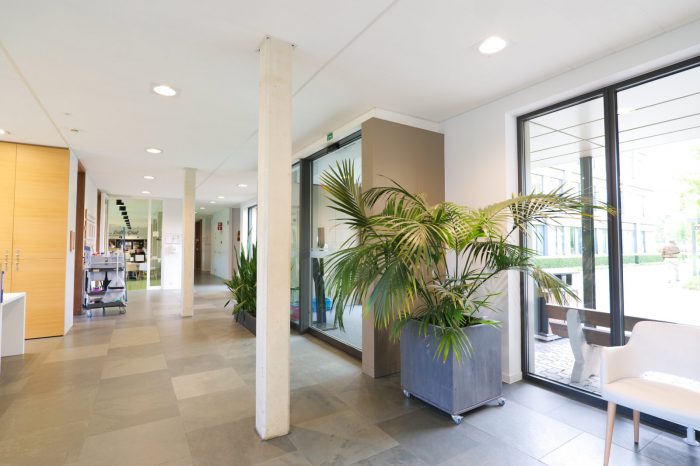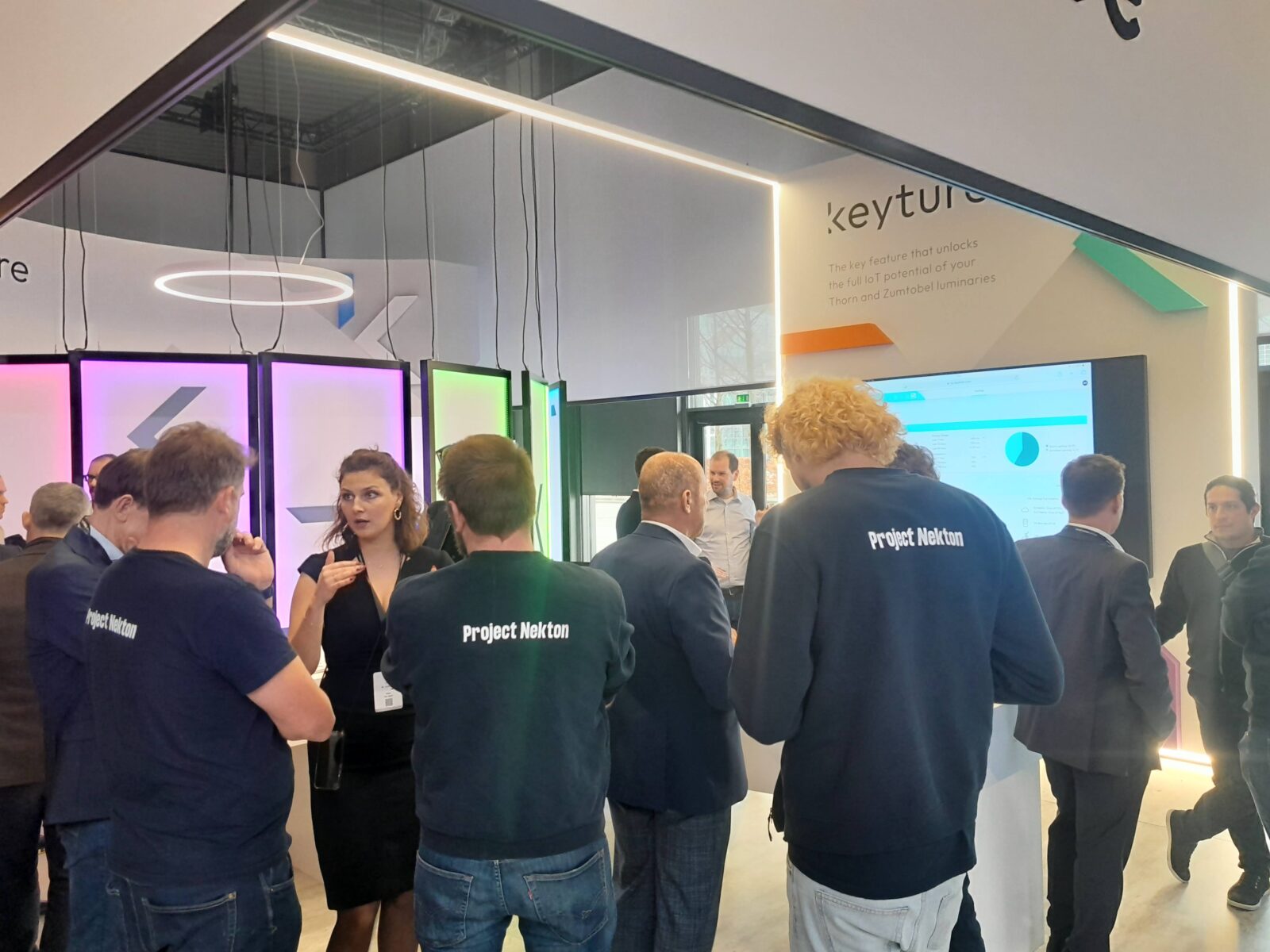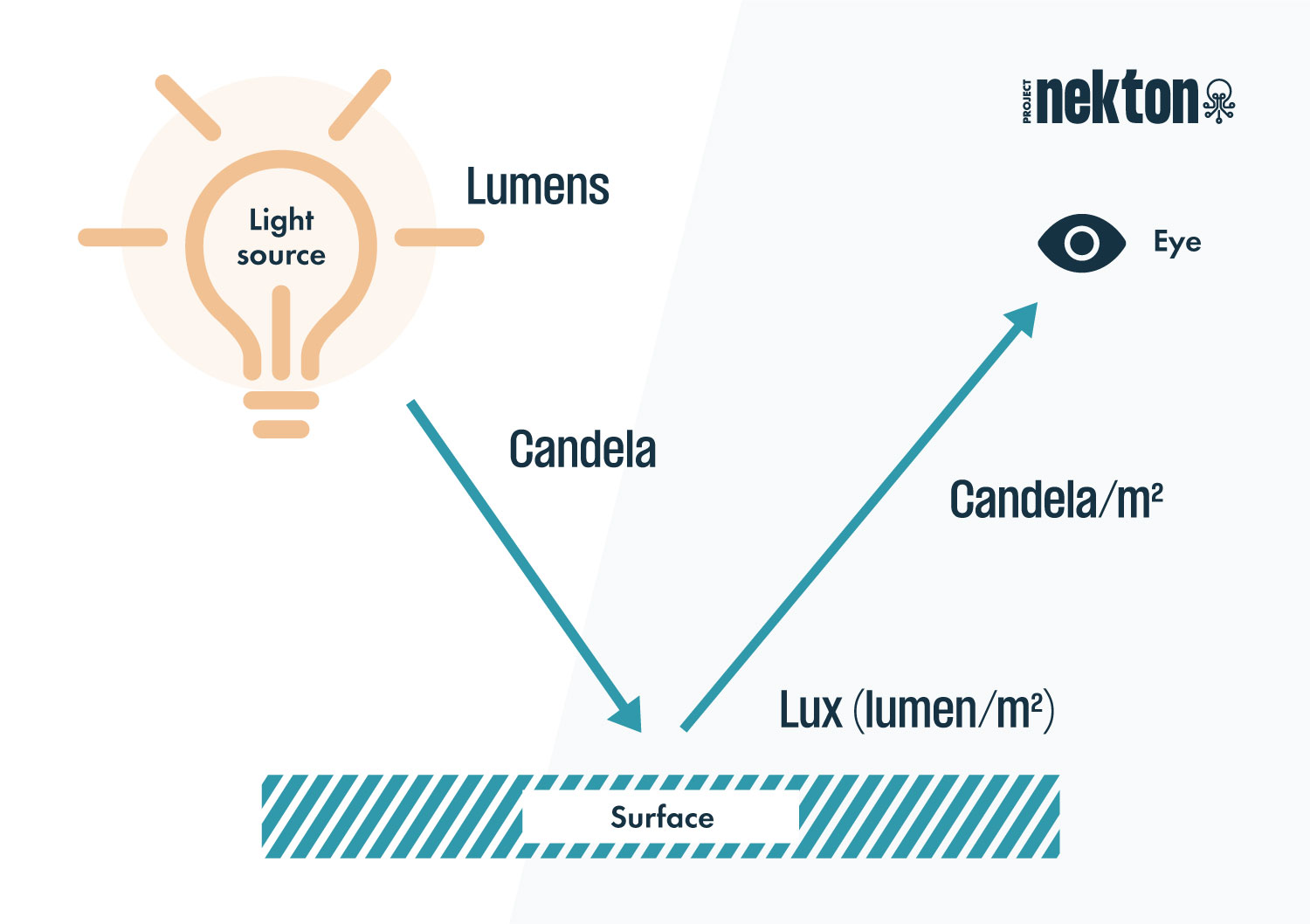Light is so much more than a simple means of dispelling darkness. In the right hands, it transforms spaces, lowers energy bills, affects well-being and even increases our productivity. But how well do we really understand the complex language of lighting?
In this article, we dive into the heart of lighting jargon. From the basic terms like lux and lumen, to more specialized terms like luminous efficacy (LOR), each concept is explained clearly and understandably, and put into context. From the subtle nuances of color temperature to the profound impact of lighting design, these terms are the building blocks of every lighting solution we offer at Project Nekton.

The 20 most important terms in lighting
Below you will find the most important terms listed.
1. LED (Light Emitting Diode)
An LED, or Light Emitting Diode, is a semiconductor light source that converts electricity into light using electroluminescence. What makes LEDs special is their efficiency and durability. They use significantly less energy than traditional incandescent bulbs and last much longer, making them an environmentally friendly and cost-effective lighting option.
2. Lumen (lm)
Lumen is the unit we use to measure the total amount of visible light emitted by a light source. This measure helps us understand how “bright” a lamp will shine. Unlike wattage, which measures the amount of energy a lamp uses, lumens directly indicate how much light you can expect from the lamp. The higher the lumen count, the brighter the bulb.

3. Lux
Lux is a crucial measure in the lighting world because it tells us how much light is actually falling on the surface we want to illuminate. Measured in lumens per square meter (lm/m²), lux gives us a concrete appreciation of how bright a given area will be. This measurement is especially important in situations where precision in lighting is required, such as in museums, offices, or surgical procedures.
4. Color Temperature
Color temperature refers to the color of light emitted by a light source, measured in Kelvin (K). This term is crucial in determining the atmosphere of a room. Lower Kelvin values produce a warmer, more relaxing light that is often yellowish in hue, while higher values produce a cooler, more stimulating light that can appear bluer. Choosing the right color temperature can significantly affect the aesthetics and functionality of a room.
5. CRI (Color Rendering Index)
The Color Rendering Index (CRI) is an essential measure in the lighting industry. It assesses how accurately a light source renders the colors of different objects compared to a natural light source such as sunlight. CRI values range from 0 to 100, with a higher score indicating more accurate color reproduction. This measurement is critical in environments where color accuracy is crucial, such as in graphic design, photography, and medical applications.
6. RGB (Red, Green, Blue)
RGB stands for Red, Green, Blue – the primary colors of light. This color model is fundamental in LED lighting technology. By adjusting the intensity of these three colors, LEDs can create a broad spectrum of colors. This makes RGB LEDs particularly versatile; they are used not only for ambient lighting and art installations, but also in displays and signaling devices. This flexibility makes the RGB model an essential tool in both artistic and functional aspects of lighting design.
7. Candela
Candela is the standard unit of light intensity, measured from the perspective of the human eye. It represents the amount of light emitted in a specific direction and is essential for understanding the “strength” of a light source. This measurement is especially important in applications where the direction of light is essential, such as in spotlighting in theaters, in vehicle headlights or in street lighting.
8. Glare factor (UGR – Unified Glare Rating)
UGR, or Unified Glare Rating, is a crucial measure in lighting design. It assesses the degree of glare experienced in a room with artificial lighting. A high UGR rating means there is a greater chance of uncomfortable or even harmful glare, which is especially important in work environments. Minimizing the UGR in spaces such as offices, schools and hospitals is essential for user comfort and well-being.
9. LOR (Light Output Ratio)
LOR, or Light Output Ratio, is a measure of the efficiency of a lighting fixture. It measures the ratio of the amount of light emitted by the luminaire to the total light produced by the lamps. This ratio takes into account losses due to reflection, absorption and other factors. A high LOR means that a fixture is effective in utilizing the light produced by the lamps, leading to improved energy efficiency and cost savings.
10. Lumen per watt (Lm/W)
Lumen per watt (Lm/W) is the measure of efficiency of lighting systems, indicating how much light (in lumens) is produced per watt of electricity consumed. This allows users to compare the performance and energy efficiency of different lighting solutions.
11. Uniformity
Uniformity represents the uniformity of light distribution in a given space. It is often expressed as the ratio of minimum to maximum lighting levels within the area. Uniformity is important for creating a comfortable and visually consistent environment. The higher the uniformity ratio, the more evenly distributed the light is and the more uniform the lighting in the room is perceived to be.
12. Relighting
Relighting refers to the process of upgrading or replacing existing lighting systems with more energy-efficient options, such as LED lighting. This process is not just about replacing old lamps; it is an opportunity to improve lighting quality, increase energy efficiency and reduce operational costs. Relighting can have a significant impact on a building or space, not only by improving aesthetics and functionality, but also by contributing to sustainability goals.
13. Ambient light
Ambient light in a space includes all light sources, both natural and artificial. It is the general level of light in an area, which is the basis for the overall atmosphere and functionality of that space. This can range from the bright daylight streaming through windows to the subtle glow of sconces. Proper management of ambient light is crucial to creating a pleasant and functional environment, whether at home, in the office or in a public space.
14. Lighting control
Lighting control is the process of managing and adjusting lighting. It can range from simple systems such as manual dimmers and switches to complex, automated systems that use sensors and sophisticated software. Lighting control allows users to improve the atmosphere, energy consumption and even the well-being of the people in the space. With the right lighting control, lighting can be tailored to specific needs and activities, providing both comfort and efficiency.
15. Light-as-a-Service (LaaS)
Light-as-a-Service (LaaS) is an innovative business model that radically changes the way we think about lighting. Instead of viewing lighting as a one-time capital investment, LaaS provides lighting as an ongoing service. Customers pay for their lighting infrastructure and services based on usage and performance. This model allows customers to access the latest lighting technologies without heavy initial investments. It is a cost-effective, flexible solution that allows companies to continuously update and optimize their lighting systems.

16. Smart lighting
Smart lighting represents the next generation in home and office technology. These LED lighting systems are connected to a network and can be controlled and adjusted remotely through an app or other digital platform. Users can adjust lighting in terms of color, intensity and timing, often with just a few taps on their smartphones. Smart lighting can also be integrated with other smart home or office systems for a seamless, automated experience, making it a key part of the modern lifestyle and workplace.
17. Dimmability
Dimmability is a feature of LED lighting that allows users to adjust light intensity. This functionality can often be achieved with a dimmer or advanced control system. The ability to change the brightness of a lamp allows users to adjust lighting to their specific needs and preferences, leading to improved comfort and atmosphere. Dimmability is also beneficial for energy conservation, as lowering the light intensity reduces the energy consumption of the lamp.
18. Motion Sensor
A motion sensor is a smart device that detects motion within its range. These sensors are widely used in lighting systems to save energy and increase convenience. When motion is detected, the sensor automatically turns on the lights. If there is no more motion, the lights are turned off again after a preset period of time. This makes motion sensors ideal for places such as hallways, washrooms, and parking lots, where leaving lights on constantly would be unnecessary and wasteful.

19. Daylight sensor
A daylight sensor, a specific type of light sensor, is designed exclusively to measure the amount of natural daylight. These sensors play a key role in smart lighting systems by adjusting the amount of artificial light based on available daylight levels. The use of daylight sensors not only helps reduce energy consumption, but also creates a more pleasant and healthier environment by making maximum use of natural light.

20. High End Trimming
High End Trimming is an advanced feature in lighting systems that allows fine tuning of the maximum light output of individual fixtures. This feature is particularly useful for meeting specific lighting requirements, such as maintaining uniformity in lighting or achieving additional energy savings. By cutting out “superfluous” light, High End Trimming not only reduces energy consumption but also contributes to longer luminaire life
Conclusion
In the world of enlightenment, knowledge is power. By understanding these 20 key concepts, you will have laid a solid foundation for making the most of the power of lighting! Whether it’s creating the perfect ambiance, improving energy efficiency or implementing advanced lighting technologies, it all starts with a solid understanding of these terms.
At Project Nekton, we understand that every lighting project presents its own unique challenges and opportunities. Whether you are looking to upgrade a small office or planning a large-scale lighting design for an entire factory, we are ready to support you with our lighting solutions.
Still have questions about how these concepts can be applied to your specific project? Or are you curious how the latest lighting technologies can improve your space? LED’s talk!

































